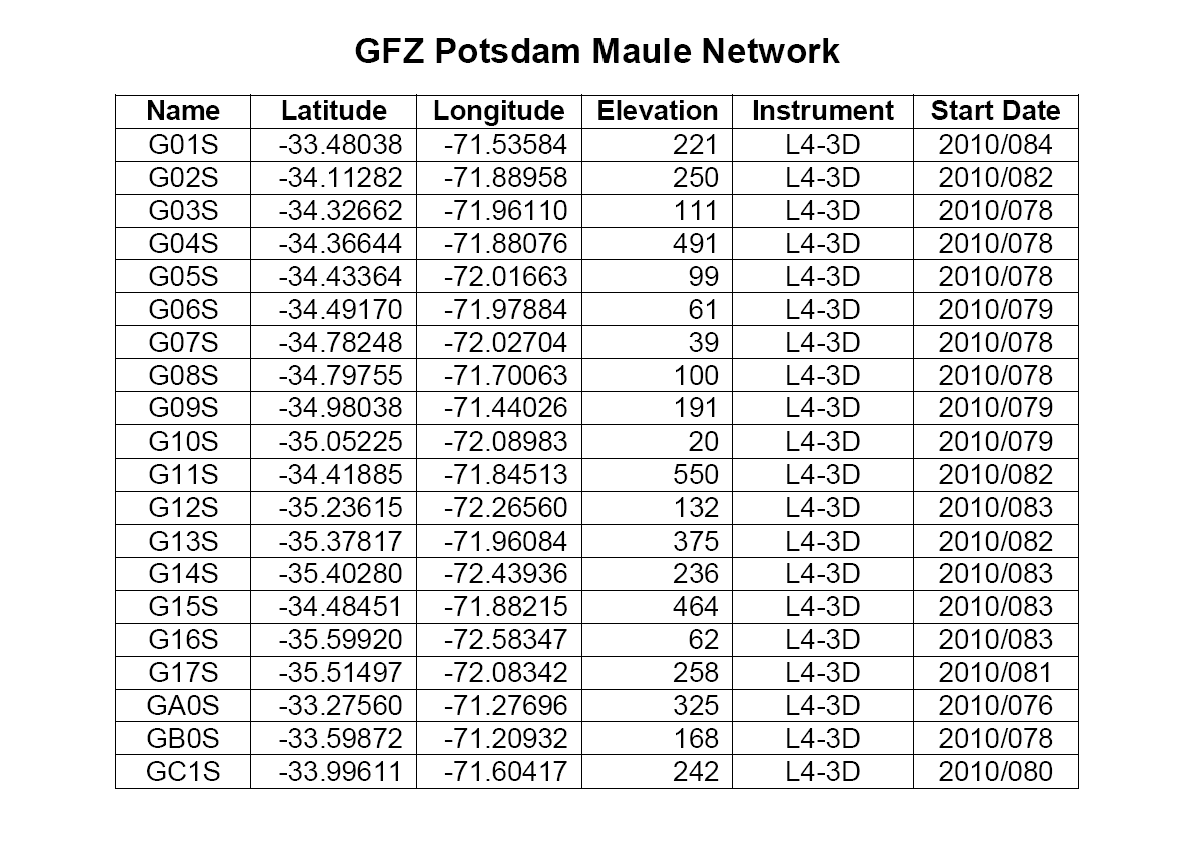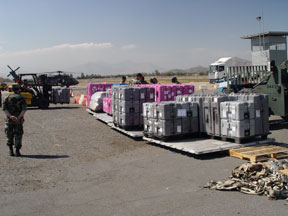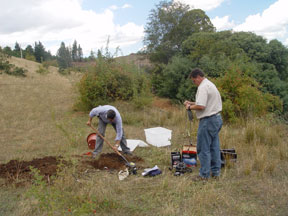By IRIS Webmaster on July 17th, 2010
We are looking forward to collecting data from the most recent events, including the Mw=6.5 aftershock of July 14th near Bio-Bio, Chile. We had the good fortune of sunny weather during training and we all hope it continues into the main effort of collecting data from the stations. Our Chilean colleagues at the University of Chile in Santiago gave us a head start with respect to field preparations, allowing team members to concentrate on last minute packing and training. The servicing effort to collect data from the sites is truly an international team effort.
 |
|
By David Simpson on July 14th, 2010
Carl Ebeling from Northwestern University and George Slad from the PASSCAL instrument Center arrived in Chile this week to work with the staff of the University of Chile to start a service run to collect the last two months of data from all of our stations. This will be the final service run before the instruments are removed at the end of September.
We have been able to install real-time cell phone telemetry at four of the IRIS stations. An example of data for the magnitude 6.5 aftershock on July 14 from three of these stations are shown under the "Data" tab on the left. The real time data can be retrieved from the IRIS DMC via the BUD system. All of the archived data from earlier data collections are also available through the DMC . See the "Data" tab on the left for details.
We have been notified by the GFZ group in Potsdam that, as agreed, they are releasing the first three months of data from their portable deployment. This is a wonderful example of open data sharing. The coordinated sharing of data will greatly benefit all of the groups who deployed instruments following the February earthquake. During the AGU meeting in Brazil in August, Susan Beck will meet with representatives from the University of Chile and others involved in the international aftershock deployments to further coordinate on developing unified data distribution.
The following was received from Frederik Tilmann regarding the German network in Chile:
The GFZ Potsdam Maule aftershock network data is now available up to the last service run at the end of May through GEOFON (http://geofon.gfz-potsdam.de).
Note that there is a limit of 5 GB per request for requests via the Web interface or other ArcLink requests (e.g. via ObsPy). If you want to download the whole time period, each station has to be requested separately. You can fire off (separate) requests for all stations during one session, though. For technical issues with data requests, please contact Susanne Hemmleb.
BREQ_FAST requests are (currently) limited to 500 MB per request. We are planning to upgrade this shortly, but for now BREQ_FAST requests are not encouraged for this reason.
Station list is below.
Project page (in German): http://www.geo-x.net/forschung/gemeinsame-forschungsprojekte/feldexperiment-chile/forschung.html
You are encouraged to contact one of the GFZ seismologists involved in this project (Frederik Tilmann, Bernd Schurr, Christian Haberland) if you would like to make use of this dataset.
Regards,
Frederik
--
Frederik Tilmann
Helmholtz-Zentrum Potsdam, Deutsches GeoForschungsZentrum
Sektion 2.4, Seismologie
Telegrafenberg, Haus A3
14473 Potsdam
Tel.: +49 331-288 1240
Fax: +49 331-288 1277
E-mail: tilmann@gfz-potsdam.de
 |
Click on the image to view larger version. |
By Aaron Velasco on May 20th, 2010
Noel, George, and I arrived safely in Chile and have been greeted with open arms! After arriving this morning, we went directly to the University of Chile (UC) where we have laid out our tentative plans for servicing the seismic stations. Diana Comte has been phenomenal in helping us, especially given that we want to get out into the field tomorrow - and then find out that tomorrow is a holiday (the UC and many businesses will be closed)! Diana was able to get us access to the UC tomorrow, and Ismael Ortega (UC) will join our group. Tomorrow (Friday), we plan to service two stations as one team, carefully looking at data quality. We will then return to Santiago to regroup, and then begin our service run on Saturday to the south by splitting into two teams. The extra solar panels have not arrived (stuck in US Customs) and we hope that they are not required in the north. The first couple of evenings (Sat. and Sun.), the two teams plan to meet at the end of the day to touch base and further strategize if there are issues. From there, we will likely send a team to begin a service run in the south, and have them work their way to the north.
That's it for now!
By IRIS Webmaster on April 2nd, 2010
George, Mouse, Brian, and I are in Santiago. We're expecting Ray, Mario, and Bob any time now. If they were successful today, all the stations will be installed.
George and I installed T6, PTN2, and T8 yesterday.
Our luck with wonderful hospitality and good food continued. At our last station, which we installed as the sun was setting, the folks at the house invited us to sit on the porch with them when we were done. They served us sprite, tea, bread with avocados, and warm fresh homemade doughnuts - I am not making this up. A very nice way to finish up our installations.
I fly back to the US tomorrow. I'll work on my accounting now and make sure the directions for all the stations are clear on the installation sheets, at least as clear as "turn left at the gravel road" can be.
Ciao!
By IRIS Webmaster on March 31st, 2010
On Tuesday, we installed the stations in Hualane and Duao. The stations in Peralillo and Pichilemu were installed today.
We didn't get to T6 today. We'll do that tomorrow along with T8 and PNT2. It took us a bit of time to find a site at Pichilemu, but we did find a nice site at a small school. Six kids, ranging in age from 6 to 10 or 11, got a lesson in broadband seismology! We'll forward a photo.
Also, the empanadas in Pichilemu are very good. You'll recall that at Hualane, we received coca cola and a homemade Easter cake to take with us when our installation was completed. Today at Peralillo, George and I each received two bottles of wine compliments of the general manager of Los Vascos Winery where U67B is installed.
We plan to install T6, T8, and PTN2 tomorrow (Thursday). If they're up for it, we'll send Ray, Mario, and Bob on a coastal run to install Navida, T5, PTN1, and T7. That should take two days. By Friday all the stations should be in.
By IRIS Webmaster on March 31st, 2010
Ray Russo arrived in Santiago on Monday. Steve Roecker brought Ray up to speed on the current field activities before he returned to the US.
We now have an updated deployment map showing the locations of all the installed instruments. Thank you, Ray!
By IRIS Webmaster on March 28th, 2010
As of this morning we have 32 stations operating. The loaner sensors in all but three of the original 8 sites have been replaced with sensors that arrived from the U.S. last week.
Also note that we are installing Episensors at some sites with 6-channel data acquisition systems. I don't know how we want to do the nomenclature for multi-sensor sites (maybe count them as two stations?).
Finally, we will be doing a short term (overnight) deployment of 6 Episensors in the Concepcion area tonight (Sunday).
We should finish the southern part of the deployment by Tuesday. The remainder of our work will be between Curico and Santiago.
Cheers,
Steve
PS. Just felt a pretty good sized event here in Chillan as I typed that signoff - I'm going to guess magnitude 5.3.
By IRIS Webmaster on March 22nd, 2010
Shipment with equipment arrived last night about 8:30PM, too late for the Chileans to unload it.
We got to the airport this morning about 10 AM, too early for the Americans to show up to open up the plane.
Finally got eveyone in the same place about 1PM. Unloaded, trucked to the university, and offloaded.
We are ready to go. With any luck, the equipment heads south tomorrow with our first deployment team.
So far so good.
 |
Pallets of equipment are inspected after arriving in Chile. (Photo by Steve Roecker) |
By IRIS Webmaster on March 21st, 2010
Steve, Bob, and Mario arrived back in Santiago last night and have 8 stations deployed in the southern part of the rupture area.
Anne Meltzer arrived this morning!
Based on Steve and Bob's experience, we are meeting this afternoon to update our plans for station locations, logistics, materials needed etc. It was good to have this experience installing the initial eight stations as it will make the main deployment go better. One small issue is where to get sand. It is a large volume to take in the trucks but the ground is pretty much clay so there is no local source (of course we can buy the sand and transport it or buy it in Concepcion and transport it). The equipment should arrive today and clear customs tomorrow. Steve and Diana will go to the airport in the morning.
Steve and Bob tried google earth maps but it does not work that well in the field (lots of vegetation and gaps in the coverage) so we have some road maps electronically that Sergio got for us that we may try to print out. We are still not sure how well they will work.
Sergio and I filmed with the Discovery Channel for several hours yesterday at the University. I have no idea how much if any they will use. The program is about how lessons learned about the Chile earthquake can be used for understanding the Pacific Northwest earthquake that is expected.
That is it for today. I leave tonight. Updates will continue but not as often as the teams will be in the field.
By IRIS Webmaster on March 19th, 2010
By IRIS Webmaster on March 18th, 2010
Steve, Bob and Mario got 2 stations deployed yesterday and almost got a third, but a bridge was out. Today they were in contact with Mark Miller from the Discovery Channel and had a plan to meet for him to film them deploying a station.
I am working on a way to get part of the equipment to Talca and stored at the University of Talc with Felipe Leyton (a former student of Keith Koper's at St. Louis and now a faculty member at the University of Talc), and part of the equipment sent to Concepcion so that it is distributed. This will cut down on driving time as it would not be easy to constantly go back to Santiago for equipment. It is too expensive to get a truck to shadow the deployment teams.
As we discussed earlier, Sergio would really like some site response data for the basin around Concepcion. We plan to put the strong ground motion sensors there (the recorder with 6 channels). Sergio asked if we would consider putting a few other stations around the city for 24 hours for site response. Even one day of data would make a huge difference. I will talk to Steve about the details. Felipe can help us find sites etc. for this.
Walter Mooney is back in Santiago and is at the Embassy for a briefing this afternoon. He leaves tonight. He gave accelerometers to the engineers and they are deployed.
I have arranged for the Discovery Channel to come to the Department of Geophysics on Saturday morning to talk and film with Sergio. They have been all over Chile but have not talked to any Chileans. We will see if it works out.
I am looking into better maps for the field. Most groups are using tourist road maps but Steve said that more detailed maps would help. I hope to be able to get them tomorrow.
Still no reports of ground rupture for the shallow normal fault aftershock. The GFZ group is in the region today deploying stations. They said they would be looking.
 |
Bob Greschke, IRIS PASSCAL, and Mario Pardo, University of Chile, installing one of the first stations. (Photo by Steve Roecker) |
By IRIS Webmaster on March 17th, 2010
I just returned from my visit to the Embassy. I met with Ambassador Simons for 30 minutes along with Mary Brett Rogers-Springs (Environment, Science, Technology & Health Officer) and Dinah Arnett. I thanked them and we discussed the earthquake and the need for collaboration. The Ambassador was interested in the kinds of things that we would learn from the deployment.
I also met some of the military team that were sent to Chile right after the earthquake. It turns out that the person in charge of the Unit (Matheson, not sure his rank) is stationed in Tucson at the Air Force base and got one of his degrees from the University of Michigan. He is going to bring his 13-year-old son by my office later this spring when he gets back to Tucson.
I also met Sidney Velado, the regional Advisor for USAID/OFDA who is familiar with seismology and works works with Estella Minya, my contact in Bolivia.
I thanked everyone for their help and continued support and explained our project a little more to them. Dinah wants to follow up in May when the AGU Chapman conference is in Valpriso, Chile. Everyone was extremely helpful.
Steve Roecker and his team made it to Concepcion last night without any problems. I should be getting an update tonight from him. I will spend the next two days at the University of Chile working with the Chileans and others on coordinating.
By IRIS Webmaster on March 16th, 2010
A brief update from Susan Beck in Santiago.
Susan and Steve Roecker arrived in Santiago on Sunday and met with representatives from the University of Chile, French and German teams. There was a meeting at the University on Monday led by Sergio Barrientos with the international teams to discuss deployment and siting plans and data coordination. The Chileans are strongly encouraging open sharing of data. The French and German teams have already installed a number of stations in the aftershock zones (a mixture of short period, broadband and accelerometers). A total of ~140 stations (including our 60 and existing Chilean stations) is anticipated. Another group meeting is planned for Friday.
There was a magnitude 6.7 event on Monday night.
Steve Roecker, Bob Greschke (PASSCAL) and Mario Pardo (U Chile) travelled to Concepcion on Tuesday to collect eight PASSCAL instruments that had arrived in Chile just before the earthquake for an experiment at Villarrica volcano led by Greg Waite (Michigan Tech). Waite has agreed to have the instruments installed in the Concepcion region by our team this week, to be replaced with our equipment after it arrives this weekend.
The shipment of 60 PASSCAL/USArray instruments is expected to arrive in Santiago this Sunday, March 21 and installation will begin next week. The initial deployment teams will be Steve Roecker, Anne Meltzer (Lehigh), Angela Reusch (N Carolina A&T) along with Bob Greschke, Bruce Bonnett and George Slad from the PASSCAL Instrument Center. The University of Chile group is being very supportive of our effort in providing people, lab space, vehicles, accommodations and other resources. Members of their staff intend to join our install teams during deployment.
Dinah Arnett (our main contact at the embassy) has arranged for Susan Beck to meet with Ambassador Simons and ESTH officer Mary Brett Rogers-Springs on Wednesday morning. Susan has been in contact with Walter Mooney of the USGS. A roundtable discussion on the earthquake is planned at the Embassy on Thursday afternoon.
Susan promises more details soon.